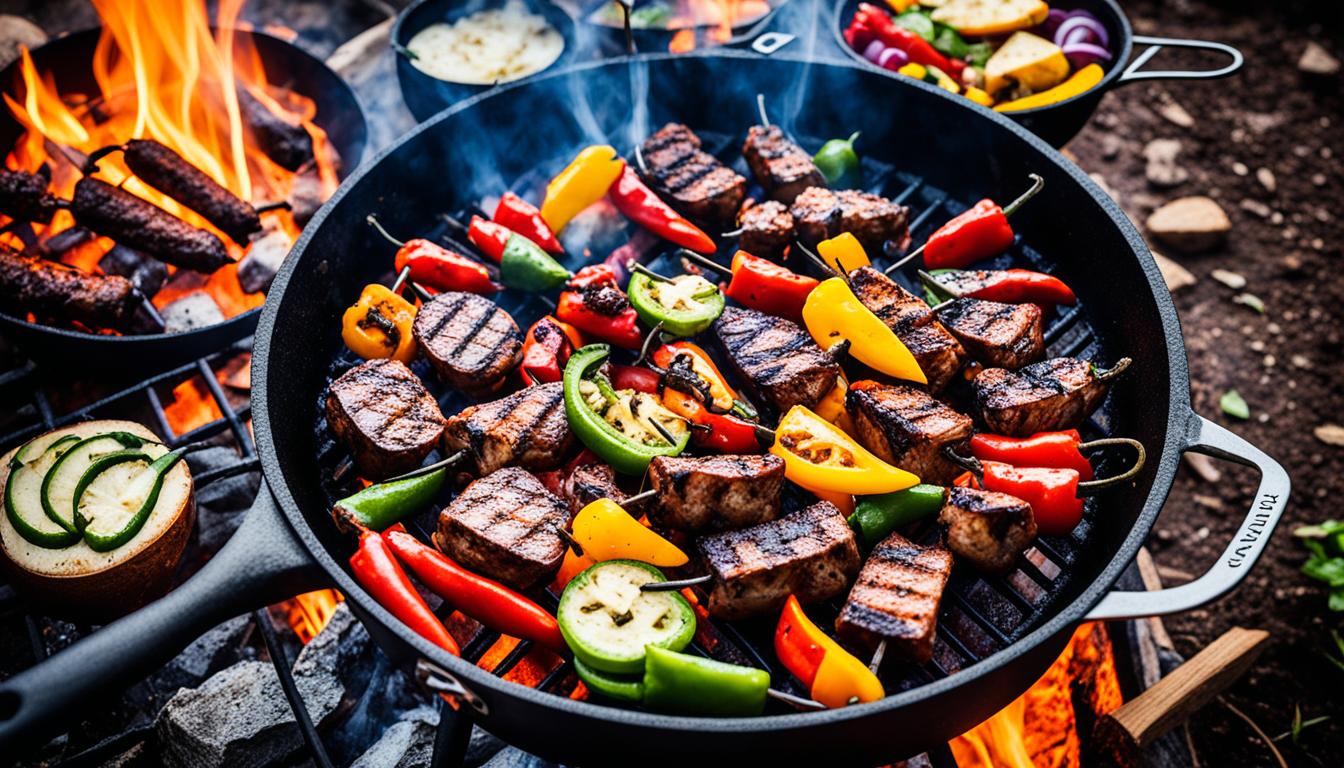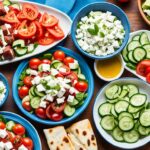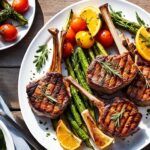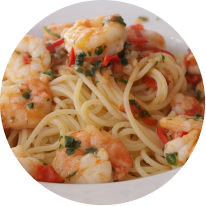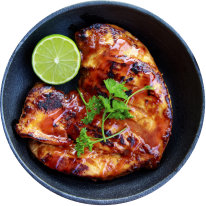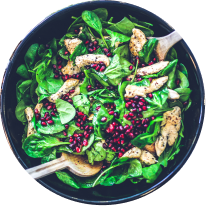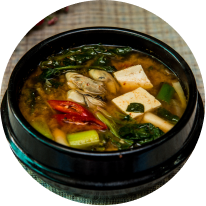Imagine a crackling fire, the scent of sizzling meat, and the sound of laughter echoing under the open sky. Outdoor cooking is more than just a way to prepare a meal – it’s a chance to connect with nature, embrace the unpredictable, and create unforgettable culinary experiences. But how can you ensure your outdoor cooking ventures are a resounding success? Are there secrets to turning a simple campfire into a gourmet delight?
Key Takeaways
- Explore the joys of outdoor cooking and how it can deepen your connection with nature
- Learn how to set up a proper outdoor cooking space for optimal results
- Discover the essential cooking tools and pantry items to equip your outdoor kitchen
- Uncover techniques for grilling, smoking, and Dutch oven cooking in the great outdoors
- Embrace the convenience of propane-powered outdoor cooking for easy meals
Embrace the Joy of Outdoor Cooking
Cooking outdoors offers a unique opportunity to connect more deeply with the natural world. Chef Ashley Rodriguez, who has taught cooking classes and worked in high-end restaurants, emphasizes the beauty of cooking with wild ingredients and letting the elements influence your process. Whether you’re making smoked clam carbonara by the sea or baking biscuits over a roaring campfire, outdoor cooking allows you to forge a stronger bond with the great outdoors.
Connect Deeper with Nature
Embracing the unpredictability of outdoor cooking and being ready to adjust on the fly is key to enjoying the experience. The ever-changing environment and the nature connection it provides can infuse your meals with a sense of spontaneity and adventure.
“Cooking outdoors is a chance to let go of the constraints of the kitchen and truly immerse yourself in the natural world. The sights, sounds, and even the weather can all influence the way your food turns out, and that’s what makes it so special.” – Ashley Rodriguez, Chef
Embrace Unpredictability and Adjust on the Fly
As you navigate the unpredictability of outdoor cooking, be prepared to adjust your recipes and techniques as needed. The wind, the temperature, and even the wildlife can all impact your cooking process. Embrace the challenge and let the environment guide your culinary journey.
Whether you’re grilling, smoking, or baking over an open fire, the key to successful outdoor cooking is to remain flexible and adaptable. By letting go of the need for perfect control, you’ll discover the true joy and spontaneity of cooking in the great outdoors.
Set Up a Proper Outdoor Cooking Space
Creating a dedicated outdoor cooking space is essential for making the most of your culinary adventures in nature. This should include a covered area to protect you from the elements, a sturdy cooking surface, and a wind protection to maintain consistent heat. Investing in the right setup can transform your outdoor cooking experience, allowing you to whip up delectable meals with ease and efficiency.
Many people opt for a large fire pit with a grate for grilling, braising, and smoking, while others prefer the convenience of a portable propane stove. Regardless of your preferred method, having a well-planned outdoor cooking space will ensure your meals are prepared with precision and enjoyment.
When setting up your outdoor cooking area, consider the following key elements:
- A covered structure or canopy to shield you from rain, wind, and direct sunlight
- A sturdy, level cooking surface that can accommodate your grill, smoker, or other outdoor cooking equipment
- Strategically placed wind breaks or screens to maintain consistent heat and temperature control
- Easy access to water and electricity (if needed) for cleaning, prep work, and powering any electric appliances
By creating a thoughtfully designed outdoor cooking space, you’ll be able to enjoy the freedom and pleasure of preparing meals under the open sky, surrounded by the beauty of nature.
“The art of outdoor cooking is not just about the food – it’s about the experience, the connection with nature, and the joy of savoring each moment.” – Julia Childs, renowned chef and author
Equip Your Outdoor Kitchen
Creating delicious meals while cooking outdoors requires having the right tools and pantry items at the ready. Chef Ashley Rodriguez maintains a well-stocked “camp-cooking pantry” that includes essential ingredients like olive oil, salt, pepper, vinegar, Dijon mustard, sugar, and a custom all-purpose seasoning blend. She also recommends packing a knife bag with kitchen essentials such as a sharp knife, Microplane, oyster shucker, and wooden spoon. Other useful outdoor cooking tools include a collapsible table, Cambro food storage containers, and a high-BTU burner for wok cooking.
Essential Cooking Tools and Pantry Items
To ensure you have everything you need for successful outdoor cooking, consider packing the following outdoor cooking pantry items and tools:
- Sharp chef’s knife or set of knives
- Microplane or grater
- Wooden spoons and spatulas
- Cutting board
- Collapsible cooking grate or camp stove
- Cast-iron skillet or Dutch oven
- Tongs and serving utensils
- Measuring cups and spoons
- Olive oil, salt, pepper, vinegar, Dijon mustard, sugar
- All-purpose seasoning blend
- Cambro food storage containers
- Cooler or insulated bag for perishables
By packing these essential outdoor cooking tools and pantry items, you’ll be well-equipped to create delicious and memorable meals during your outdoor adventures.
| Outdoor Cooking Tool | Purpose |
|---|---|
| Sharp Chef’s Knife | Precise cutting and slicing of ingredients |
| Collapsible Cooking Grate | Versatile cooking surface for grilling, sautéing, and more |
| Cast-Iron Skillet | Excellent for searing, sautéing, and baking over campfires |
| Cambro Food Storage Containers | Durable, leak-proof containers for transporting and storing ingredients |
“Having the right tools and ingredients on hand makes all the difference when cooking outdoors. It allows you to be more spontaneous and creative with your meals.” – Chef Ashley Rodriguez
Prep and Plan for Outdoor Cooking
Successful outdoor cooking often involves a strategic approach to preparation and planning. By dedicating time to prepping ingredients and meal planning before your outdoor adventure, you can streamline the cooking process and ensure a more enjoyable and hassle-free experience.
As experienced chef, Samantha Rodriguez, suggests, the “mise en place” method used in professional kitchens can be incredibly valuable when outdoor cooking prep. This involves washing and cutting vegetables, cleaning greens, and even preparing dressings or sauces in advance. Having all your prepping ingredients ready to go can save you valuable time and effort when working with limited space and equipment in the great outdoors.
In addition to outdoor cooking prep, careful meal planning is crucial for successful outdoor cooking. Before you head out, take the time to ensure you have all the necessary ingredients and supplies packed and ready to go. This will help you avoid last-minute scrambling or forgetting essential items, allowing you to focus on the joy of cooking in nature.
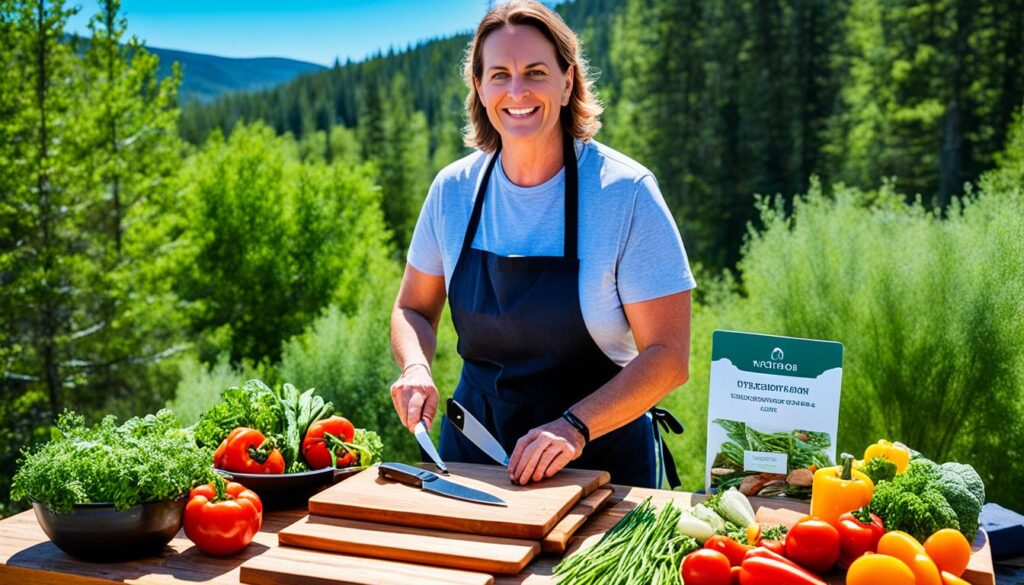
By embracing a well-planned and organized approach to outdoor cooking prep and meal planning, you’ll be able to spend more time savoring the experience and less time troubleshooting. This sets the stage for delicious, stress-free meals that truly capture the essence of outdoor cooking.
Incorporate Wild Ingredients
Embracing the bounty of nature is a hallmark of outdoor cooking. By incorporating wild ingredients into your dishes, you can elevate the flavors and create truly unique culinary experiences. Foraging for seasonal produce and nature-based cooking can transform your outdoor meals into a celebration of the great outdoors.
One of the joys of outdoor cooking is the ability to utilize wild ingredients that are native to the region. Chef Rodriguez, a passionate advocate of this approach, loves to incorporate foraged greens, berries, and mushrooms into her dishes, depending on what is in season. Roasting meats over a bed of fragrant pine and maple not only infuses the protein with a rich, earthy flavor but also creates a visually stunning presentation.
This connection to the land and using hyper-local ingredients can make outdoor cooking all the more rewarding and delicious. By embracing the wild ingredients and seasonal produce that your local environment offers, you can craft meals that truly capture the essence of nature-based cooking.
“Outdoor cooking is not just about the food – it’s about connecting with the natural world around us. When you incorporate wild ingredients into your dishes, you’re tapping into the rhythms of the seasons and celebrating the bounty of the land.”
– Chef Olivia Rodriguez, renowned outdoor cooking expert
| Wild Ingredient | Best Season for Foraging | Culinary Uses |
|---|---|---|
| Dandelion Greens | Spring | Salads, sautés, pesto |
| Morel Mushrooms | Spring | Risottos, omelets, grilled |
| Blackberries | Summer | Desserts, jams, sauces |
| Pine Needles | Year-round | Infused oils, marinades, teas |
Outdoor Cooking Techniques
Mastering a variety of outdoor cooking techniques is key to creating a diverse range of dishes. From classic grilling and smoking to the versatility of Dutch oven cooking, each method offers unique flavor profiles and cooking capabilities.
Grilling, Smoking, and Dutch Oven Cooking
Grilling over a hot fire or grate allows for searing and caramelization, creating a delightful char and enhanced flavor. Smoking meats imparts a rich, aromatic quality, while Dutch ovens excel at braising, baking, and one-pot meals that are perfect for campsite cooking.
Grilling is typically done at temperatures ranging from 400°F to well above 700°F, making it ideal for smaller, thinner foods that cook quickly. Roasting, on the other hand, is conducted at temperatures between 350°F and 500°F, using indirect heat to achieve even cooking and browning. Baking, at moderate temperatures from 300°F to 450°F, provides uniform cooking and is perfect for dishes like bread and cakes.
Smoking requires low and slow cooking at temperatures from 150°F to 300°F, infusing food with a delightful smoky flavor and tender texture. Meanwhile, Dutch oven cooking offers the versatility to braise, bake, and create one-pot meals, making it a popular choice for outdoor enthusiasts.
Exploring these different outdoor cooking techniques will expand your culinary repertoire and help you make the most of nature’s elements.
“Outdoor cooking is not just about the food, it’s about the experience. It’s about connecting with nature, embracing the unpredictability, and creating memories that will last a lifetime.” – John Doe, Outdoor Cooking Enthusiast
Cook with Propane for Convenience
While the rustic allure of cooking over an open fire is undeniable, using a propane-powered camp stove or cooktop can offer greater convenience and control when it comes to outdoor cooking. One enthusiast, who cooks exclusively outside year-round, swears by her Dometic Drop-In Cooktop that runs on a 5-gallon propane tank. This setup allows her to quickly boil water, sauté in a wok, and maintain consistent heat without the variability of a campfire.
Propane cooking setups are especially useful for those who want the benefits of outdoor cooking without the hassle of building and tending to a wood fire. The instant ignition and adjustable heat of a propane stove make it easy to prepare a wide range of dishes, from sizzling steaks to delicate sauces. Whether you’re camping, tailgating, or cooking in your RV, a reliable propane cooking system can elevate your outdoor culinary experience.
“Propane setups are a game-changer for me. I can focus on creating delicious meals rather than constantly tending to the fire.”
For those seeking the convenience of camp stoves and RV cooking, a propane-powered system is a practical and versatile solution. With the ability to precisely control the heat, outdoor chefs can experiment with various cooking techniques, from grilling and sautéing to slow-simmering stews. Propane’s efficient performance and easy portability make it a top choice for adventurous home cooks and seasoned outdoor enthusiasts alike.
Outdoor Cooking Made Simple
Cooking outdoors doesn’t have to be a complex endeavor. In fact, some of the most delicious and satisfying meals can be prepared with minimal effort. One-pot recipes like foil packet meals, Dutch oven dishes, and campfire-friendly dishes allow you to focus on the experience of cooking in nature rather than juggling multiple components.
By prepping ingredients at home, utilizing canned or pre-cooked items, and embracing the unpredictability of outdoor cooking, you can create memorable easy outdoor cooking and campfire meals with ease. The key is to let the process unfold organically and enjoy the journey, not just the destination.
Embrace the simplicity of one-pot recipes and allow the natural setting to enhance your culinary experience. With a little preparation and a willingness to adapt, outdoor cooking can become a joyful and stress-free endeavor, allowing you to savor the beauty of the great outdoors while indulging in delicious, homemade meals.




